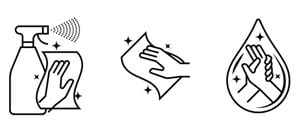Do you have issues seeing acceptable recovery of your phenols? I know I do. These compounds can be challenging to recover and quantitate, and are also found just about everywhere! Read on to learn a couple of fun facts about phenols, but first, let’s explain why phenols can be difficult to work with.
Firstly, phenol is very soluble with water and it has an affinity for water, specifically at pH 2. This can cause some challenges with extraction because when EPA Method 625.1 and 8270 samples are extracted, they are adjusted to pH 2. The phenols will want to stay in the water phase, so the media used for the solid phase extractions need to be strong enough to capture the phenols from the water sample.
Secondly, phenol can be challenging to chromatograph. When the GC is contaminated with a compound with a high boiling point, phenol is subject to erratic behavior. This would cause the phenol peak to be very hard to quantitate, again leading to challenges with determining the recovery of phenol. To remedy this, it is important to make sure your continuous calibration verifications (CCVs) are passing before running an important extract on the GC-MS. Maintenance could be completed proactively as opposed to reactively, reducing the instrument downtime. It is very important that the GC is monitored of contaminants.
Here is an interesting article I found about phenols from ScienceDirect. Did you know that some phenols are found in some aromatherapy products and essential oils? Since the essential oils have taken such a “boom” and many people are using these oils for natural therapy as an alternative to modern medicine, I thought it would be interesting to share that some may contain this harsh compound, which is surprising, considering phenols are harmful to our liver and are a skin irritant.
There are four different types of phenols found in essential oils and they are carvacrol, eugenol, cresol, and thymol. Carvacrol has a spicy odor and it is found in sage, thyme, and oregano essential oils. Eugenol has a spicy, but pungent odor that is found in the cinnamon leaf, ylang-ylang, clove, and rose essential oils. Oregano and thyme essential oils also contain thymol which has a strong herbaceous and medicated odor.
Fun Facts
Back in the day, phenols were used as antiseptics, but after the discovery of their toxicity, they are only used for cleaning agents now. Even though phenols are toxic, they have many therapeutic applications such as bactericidal, anti-infectious, and antiseptic. They also stimulate the immune system to encourage active healing and they stimulate the nervous system to be effective for depression. This is all great information, however, the cost of the toxicity of phenols to your liver is not worth the benefit. Keeping phenols as cleaning agents for surfaces and equipment is what is best here!
phenols are toxic, they have many therapeutic applications such as bactericidal, anti-infectious, and antiseptic. They also stimulate the immune system to encourage active healing and they stimulate the nervous system to be effective for depression. This is all great information, however, the cost of the toxicity of phenols to your liver is not worth the benefit. Keeping phenols as cleaning agents for surfaces and equipment is what is best here!
Feel free to look at this previous blog about phenols to learn even more about these compounds!

 Organic Workflow
Organic Workflow Peptide Workflow
Peptide Workflow Scale-Up Flash Purification
Scale-Up Flash Purification  Sample Preparation
Sample Preparation Biomolecule Purification
Biomolecule Purification Oligo synthesis
Oligo synthesis Scavengers and Reagents
Scavengers and Reagents Service & Support
Service & Support Accessories & Spare parts
Accessories & Spare parts Investors
Investors Reports & News
Reports & News The Share
The Share Corporate Governance
Corporate Governance Calendar
Calendar Sustainability
Sustainability Our Offering
Our Offering Our History
Our History Our Locations
Our Locations Leadership
Leadership